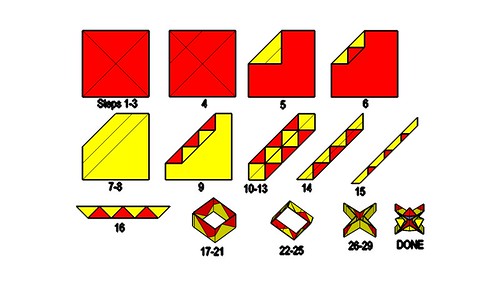Here is my reproduction of Eric Joisel dwarf in less than 30 folds and it is my first creation also:

I done it in 28 folds, if we count petal folds as one and it is created from waterbomb base
Please comment




I believe there is some confusion between a fold and a crease. I believe rule 5 defines clearly what a fold or step is. I also highlighted words from fishgoths post that show how he used ' fold' and ' step' as words with the same meaning.Fishgoth wrote: The contest is 'Kamiya Satoshi in less than 30 steps'. Your mission, should you choose to accept it, is to find a subject that complex designers, such as Satoshi, have designed. And fold your interpretation in 30 folds or less.
As an idea, here is an interpretation of 'Ancient Dragon' using only 29 steps - this is basically a preliminary base strip grafted onto a stretched bird base.
http://fishgoth.com/misc/dragon-simple.JPG
The rules:
4) Thirty folds maximum. Sunburst will judge if you are telling fibs.
5) A 'fold' is essentially a straight forward step on a diagram. It can be a valley fold, a mountain fold, a reverse fold, a petal fold or a sink. It should not be 'repeat steps 15-29 on the other side'. It should not be a series of multiple box-pleated sinks. I'm sure you get the idea.
7) You only have 30 steps, so you will have to find cunning ways to interpret insect legs, wings, tentacles, spines, clock hands, etc.
11) Please let us know how many steps your model took, and roughly describe how you folded it.
Good luck everyone. If you haven't entered this contest before, give it a go! Everyone has only 30 (or less) folds to design a model, so the playing field should be levelled a bit...
Actually, no. I am very sure that the steps would include several "repeat" steps, which were clearly excluded. For example the centipede has 22 legs, which takes 22 folds as allowed in the rules. It was also mentioned that box pleating needs several steps, and cannot be combined in one step. So the model will definitely surpass the limit of 30 folds.Niels wrote:When one reads what Fishgoth has stated in the rules, one must conclude David_D's entries are valid.
Re crimps:Niels wrote:It still isn't clear to me. If for example you need to divide the square in 3ths, is that one step: "divide in 3ths", or is that 4 steps because it requires 4 valleys. or is it even 7 steps because one needs 3 to find the references. would going form preliminary to birdbase be 2 steps? or 4 because 4 inside reverse folds are involved. or is it even necessary to diagram the precreases, wich is common in diagrams for easy models. Is it allowed to count for example 2 crimps on one side of the model as 1 step? because I see that all the time in diagrams.
fishgoth, I really like this month's subject, but it's hard to interpret the rules.
Rule 5 in full is:Niels wrote:I think the problem is if by 30 steps Fishgoth meant steps folding, or steps in a diagram.
and beacause Fishgoth typed:
5) A 'fold' is essentially a straight forward step on a diagram.
I sticked to diagram steps.
Note that fishgoth wrote a valley fold, a mountain fold, a reverse fold, a petal fold or a sink. This implies one fold per step, rather than several. So if one step includes two crimps, that's actually two steps. If you do a fold on one leg, and it needs to be repeated on the three other legs, that's four steps. "Repeat" steps were explicitly disallowed. I think the essence of the challenge is to create a model that needs very few folds. You're supposed to stretch yourself to create a model that has the essence of a super complex one, but only use very few folds.fishgoth wrote:5) A 'fold' is essentially a straight forward step on a diagram. It can be a valley fold, a mountain fold, a reverse fold, a petal fold or a sink. It should not be 'repeat steps 15-29 on the other side'. It should not be a series of multiple box-pleated sinks. I'm sure you get the idea.
I think that your creation, Niels, is a very nice elephant model. To name another example, PauliusOrigami submitted a Hermit Crab, which he said needed 33 folds. I don't care whether these models really qualify for the challenge. What I do care about is whether you're going to diagram them. Because then we can reproduce the models you invented, and I think that's what this challenge is partly about. Not everyone can fold - let alone design - super complex models. But it's great to see what you can do with just a couple of folds. And I think part of designing is also documenting what you did.Niels wrote: It looked like you read steps folding.
If Sunburst decides to stick to that reading, I withdraw my elephant.
because my elephant can be diagrammed in 30 steps, but it can't be folded in 30 'folds'.
